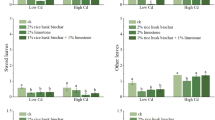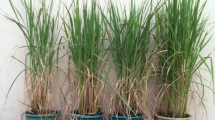Abstract
Biochar is widely used in agricultural soils or heavy metal-polluted soils to improve the quality of the soils, which would affect the growth of the plant. However, the information of biochars’ effect on the plant growth was still lacking, especially for the physiological response of the plant. Pot experiments were used to examine the effect of willow-derived biochars at two temperatures (450 and 600 °C) on cadmium (Cd) accumulation in pepper and to reveal the response of physiological parameters to exogenous Cd stress (1 and 5 mg/kg). The results showed that the accumulation of Cd in pepper roots was higher than that in pepper shoots. For low level of Cd treatments, high additional rates of the biochars could obviously reduce the accumulation of Cd in the pepper roots. Moreover, there was a negative correlation between the C content of the biochar-amended soils and the Cd content of the pepper root, suggesting that the application of biochar to the soil decreased the Cd accumulation in the root. A positive relationship between the H/C ratios of biochar-amended soils and their corresponding Cd concentrations in pepper root indicated that low thermal temperature-derived biochar could play an important role in immobilizing Cd in the soil. Furthermore, on the condition of low Cd level of treatments, the malondialdehyde content decreased in biochar-amended soils, especially at high biochar application rate. The chlorophyll content increased with increasing the rates of the biochar application. The physiological parameters indirectly proved that the application of biochar did not always alleviate the toxic effects of Cd on pepper leaves at high Cd concentration.





Similar content being viewed by others
References
Asai H, Samson BK, Stephan HM et al (2009) Biochar amendment techniques for upland rice production in Northern Laos 1. Soil physical properties, leaf SPAD and grain yield. Field Crop Res 111:81–84
Beesley L, Marmiroli M (2011) The immobilisation and retention of soluble arsenic, cadmium and zinc by biochar. Environ Pollut 159:474–480
Beesley L, Moreno-Jiménez E, Gomez-Eyles JL (2010) Effects of biochar and greenwaste compost amendments on mobility, bioavailability and toxicity of inorganic and organic contaminants in a multi-element polluted soil. Environ Pollut 158:2282–2287
Ben Ghnaya A, Charles G, Hourmant A et al (2007) Morphological and physiological characteristics of rapeseed plants regenerated in vitro from thin cell layers in the presence of zinc. C R Biol 330:728–734
Binh TN, Johannes L, James K et al (2009) Long-term black carbon dynamics in cultivated soil. Biochemistry 92:163–176
Cao XD, Harris W (2010) Properties of dairy-manure-derived biochar pertinent to its potential use in remediation. Bioresour Technol 101:5222–5228
Chen GC, Shan XQ, Wang YS et al (2008) Effects of copper, lead, and cadmium on the sorption and desorption of atrazine onto and from carbon nanotubes. Environ Sci Technol 42:8297–8302
Choudhary M, Jetley UK, Khan MA et al (2007) Effect of heavy metal stress on proline, malondialdehyde, and superoxide dismutase activity in the cyanobacterium Spirulina platensis-S5. Ecotoxicol Environ Saf 66:204–209
Cho UH, Seo NH (2005) Oxidative stress in Arabidopsis thaliana exposed to cadmium is due to hydrogen peroxide accumulation. Plant Sci 168:113–120
Cui L, Li L, Zhang A et al (2011) Biochar amendment greatly reduces rice Cd uptake in a contaminated paddy soil: a two-year field experiment. Bioresources 6:2605–2618
David D, Pascal L, Philippe H et al (2011) Physiological, anatomical and phenotypical effects of a cadmium stress in different-aged chlorophyllian organs of Myriophyllum alterniflorum DC (Haloragaceae). Environ Exp Bot 72:174–181
Dong XL, Ma LNQ, Li YC (2011) Characteristics and mechanisms of hexavalent chromium removal by biochar from sugar beet tailing. J Hazard Mater 190:909–915
Fellet G, Marchiol L, Delle Vedove G et al (2011) Application of biochar on mine tailings: effects and perspectives for land reclamation. Chemosphere 83:1262–1267
Gao B, Liu Y, Sun K et al (2008) Precise determination of cadmium and lead isotopic compositions in river sediments. Anal Chin Acta 612:114–120
Graber ER, Harel YM, Kolton M et al (2010) Biochar impact on development and productivity of pepper and tomato grown in fertigated soilless media. Plant Soil 337:481–496
Hartley W, Dickinson NM, Riby P et al (2009) Arsenic mobility in brownfield soils amended with green waste compost or biochar and planted with Miscanthus. Environ Pollut 157:2654–2662
Heath RL, Packer L (1968) Photoperoxidation in isolated chloroplasts. I. Kinetics and stoichiometry of fatty acid peroxidation. Arch Biochem Biophys 125:189–198
Hossain MK, Strezov V, Chan KY et al (2010) Agronomic properties of wastewater sludge biochar and bioavailability of metals in production of cherry tomato (Lycopersicon esculentum). Chemosphere 78:1167–1171
Huang GY, Wang YS (2010) Physiological and biochemical responses in the leaves of two mangrove plant seedlings (Kandelia candel and Bruguiera gymnorrhiza) exposed to multiple heavy metals. J Hazard Mater 182:848–854
Jones BEH, Haynes RJ, Phillips IR (2010) Effect of amendment of bauxite processing sand with organic materials on its chemical, physical and microbial properties. J Environ Manage 91:2281–2288
Karami N, Clemente R, Moreno-Jiménez E et al (2011) Efficiency of green waste compost and biochar soil amendments for reducing lead and copper mobility and uptake to ryegrass. J Hazard Mater 191:41–48
Keiluweit M, Nico PS, Johnson MG et al (2010) Dynamic molecular structure of plant biomass-derived black carbon (biochar). Environ Sci Technol 44:1247–1253
Kim KH, Kim JY, Cho TS et al (2012) Influence of pyrolysis temperature on physicochemical properties of biochar obtained from the fast pyrolysis of pitch pine (Pinus rigida). Bioresour Technol 118:158–162
Lefèvre I, Correal E, Faz-Cano Á et al (2009) Structural development, water, status, pigment concentrations and oxidative stress of Zygophyllum fabago seedlings in relation to cadmium distribution in the shoot organs. Int J Plant Sci 170:226–236
Liao SH, Pan B, Li H et al (2014) Detecting free radicals in biochars and determining their ability to inhibit the germination and growth of corn, wheat and rice seedlings. Environ Sci Technol 48:8581–8587
Lin R, Wang X, Luo Y et al (2007) Effects of soil cadmium on growth, oxidative stress and antioxidant system in wheat seedlings (Triticum aestivum L.). Chemosphere 69:89–98
Liu W, Yang YS, Francis D et al (2008) Cadmium stress alters gene expression of DNA mismatch repair related genes in Arabidopsis seedlings. Chemosphere 73:1138–1144
Liu CF, Guo JL, Cui YL et al (2011) Effects of cadmium and salicylic acid on growth, spectral reflectance and photosynthesis of castor bean seedlings. Plant Soil 344:131–141
Lopez E, Arce C, Oset-Gasque MJ et al (2006) Cadmium induces reactive oxygen species generation and lipid peroxidation in cortical neurons in culture. Free Radic Bio Med 40:940–951
Luna CM, Gonzalez CA, Trippi VS (1994) Oxidative damage caused by an excess of copper in oat leaves. Plant Cell Physiol 35:11–15
Mittler R (2002) Oxidative stress, antioxidants and stress tolerance. Trends Plant Sci 7:405–410
Monteiro MS, Santos C, Soares AMVM et al (2009) Assessment of biomarkers of cadmium stress in lettuce. Ecotoxicol Environ Saf 72:811–818
Noctor G, De PR, Foyer CH et al (2007) Mitochondrial redox biology and homeostasis in plants. Trends Plant Sci 12:125–134
Novak JM, Busscher WJ, Laird DL et al (2009) Impact of biochar amendment on fertility of a southeastern coastal plain soil. Soil Sci 174:105–113
Park JH, Choppala GK, Bolan NS et al (2011) Biochar reduces the bioavailability and phytotoxicity of heavy metals. Plant Soil 348:439–451
Radotic K, Ducic T, Mutavdzic D (2000) Changes in peroxidase activity and isoenzymes in spruce needles after exposure to different concentrations of cadmium. Environ Exp Bot 44:105–113
Rillig MC, Wagner M, Salem M et al (2010) Material derived from hydrothermal carbonization: effects on plant growth and arbuscular mycorrhiza. Appl Soil Ecol 45:238–242
Silber A, Levkovitch I, Graber ER (2010) pH-dependent mineral release and surface properties of cornstraw biochar: agronomic implications. Environ Sci Technol 44:9318–9323
Song Y, Zhu LS, Wang J et al (2009) DNA damage and effects on antioxidative enzymes in earthworm (Eisenia foetida) induced by atrazine. Soil Biol Biochem 41:905–909
Sposito G (1989) The chemistry of soils. Oxford University Press, New York
Sun K, Ro K, Guo MX et al (2011) Sorption of bisphenol A, 17 alpha-ethinyl estradiol and phenanthrene on thermally and hydrothermally produced biochars. Bioresour Technol 102:5757–5763
Sun H, Hockaday WC, Masiello CA et al (2012) Multiple controls on the chemical and physical structure of biochars. Ind Eng Chem Res 51:3587–3597
Sun K, Kang MJ, Zhang ZY et al (2013) Impact of deashing treatment on biochar structural properties and potential sorption mechanisms of phenanthrene. Environ Sci Technol 47:11473–11481
Tang B, Xu SZ, Zhou XL et al (2010) Changes of antioxidative enzymes and lipid peroxidation in leaves and roots of waterlogging-tolerant and waterlogging-sensitive maize genotypes at seedling stage. Agric Sci China 9:651–661
Uchimiya M, Chang S, Klasson KT (2011a) Screening biochars for heavy metal retention in soil: role of oxygen functional groups. J Hazard Mater 190:432–441
Uchimiya M, Klasson KT, Wartelle LH et al (2011b) Influence of soil properties on heavy metal sequestration by biochar amendment: 1. Copper sorption isotherms and the release of cations. Chemosphere 82:1431–1437
Uchimiya M, Lima IM, Klasson KT et al (2010) Immobilization of heavy metal ions (Cu(II), Cd(II), Ni(II), and Pb(II)) by broiler litter-derived biochars in water and soil. J Agric Food Chem 58:5538–5544
Uchimiya M, Wartelle LH, Klasson KT et al (2011c) Influence of pyrolysis temperature on biochar property and function as a heavy metal sorbent in soil. J Agric Food Chem 59:2501–2510
Wang X (2008) Principles and techniques of plant physiological biochemical experiment. Higher Education Press, Beijing
Xu DY, Chen ZF, Sun K et al (2013) Effect of cadmium on the physiological parameters and the subcellular cadmium localization in the potato (Solanum tuberosum L.). Ecotoxicol Environ Saf 97:147–153
Xu DY, Zhao Y, Sun K (2014) Cadmium adsorption on plant- and manure-derived biochar and biochar-amended sandy soils: impact of bulk and surface properties. Chemosphere 111:320–326
Yang Y, Shu L, Wang XL et al (2011) Impact of de-ashing humic acid and humin on organic matter structural properties and sorption mechanisms of phenanthrene. Environ Sci Technol 45:3996–4002
Yao FX, Camps Arbestain M, Virgel S et al (2010) Simulated geochemical weathering of a mineral ash-rich biochar in a modified Soxhlet reactor. Chemosphere 80:724–732
Zhang ZY, Meng J, Dang S (2014) Effect of biochar on relieving cadmium stress and reducing accumulation in Super Japonica rice. J Integr Arg 13:547–553
Acknowledgments
This research was supported by the Postdoctoral Science Foundation of China (2015M571072) and the Public Interest Scientific Research Fund of the Ministry of Water Resource (No. 201501019).
Author information
Authors and Affiliations
Corresponding authors
Additional information
Responsible editor: Elena Maestri
Rights and permissions
About this article
Cite this article
Xu, D., Zhao, Y., Zhou, H. et al. Effects of biochar amendment on relieving cadmium stress and reducing cadmium accumulation in pepper. Environ Sci Pollut Res 23, 12323–12331 (2016). https://doi.org/10.1007/s11356-016-6264-6
Received:
Accepted:
Published:
Issue Date:
DOI: https://doi.org/10.1007/s11356-016-6264-6




